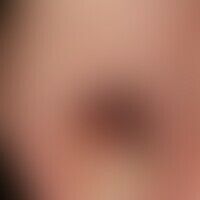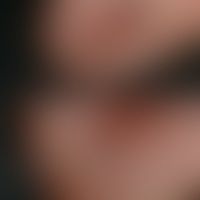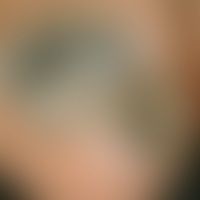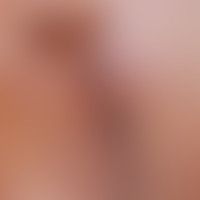
Melanoma acrolentiginous C43.7 / C43.7
Melanonychia striata longitudinalis: DD- subungual malignant melanoma; look for the discoloration of the cuticle (so-called Hutchinson's sign), as an indication of involvement of the nail root

Nail hematoma T14.05
Nail hematoma: sharply distally limited discoloration of the big toe nail. nail matrix at the distal cutting edge unchanged. no longitudinal striation of the nail.

Melanoma cutaneous C43.-
Melanonychia longitudinalis: stripy (melanotic) nail pigmentation caused by a (still benign) pigment nevus localized in the (not visible) nail matrix. The anterior incision edge of the nail plate is pigment-bearing (marked with an arrow). An initial malignant melanoma must be excluded.

Nail hematoma T14.05
Hematoma, nail hematoma. reflected light microscopy with blue, sharply defined discoloration of the nail.

Nail hematoma T14.05
Hematoma, nail hematoma. Incident light microscopy with red-blue discoloration of the nail.

Nail hematoma T14.05
Differential diagnosis of "nail hematoma": All melanocytic neoplasms of the nail matrix lead to striped pigmentation of the nail plate.

Melanoma acrolentiginous C43.7 / C43.7
Melanoma, malignant, acrolentiginous, subungual and paraungual, black pigmented tumor in the fingernail area, advanced stage with destruction of the nail.

Melanoma acrolentiginous C43.7 / C43.7
Mlelanom malignes acrolentiginous: Subungual malignant melanoma. Characteristic is the stripy growth through the entire length of the nail. The arrow marks the so-called Hutchinson sign.

Melanoma acrolentiginous C43.7 / C43.7
DD: Melanoma malignant acrolentiginous melanoma; here: complicating onychomycosiswith bleeding after banal trauma.

Onychomycosis (overview) B35.1
tinea unguium: black dyschromia of the nail plate localized at the left big toe of a 52-year-old man, increasing for more than one year. border zone to the healthy nail plate marked proximally by a horizontal arrow. cuticle not discolored (vertical arrows: speaks against a melanocytic tumor). nail plate itself is discolored (see anterior incision margin marked by a star). Trichophyton rubrum and Aspergillus spp. have been culturally proven.
